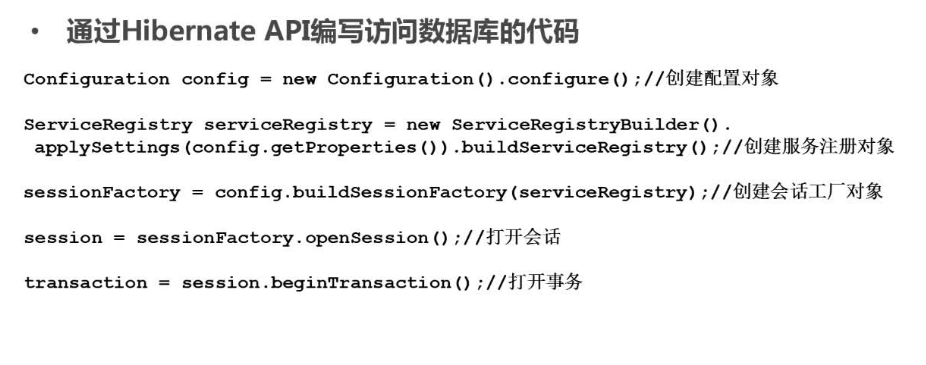
Hibernate充当持久化层
项目结构:

一、创建项目导入jar包。
hibernate-core & junit4 & mysql-jdbc
二、src目录下创建hibernate.cfg.xml文件配置hibernate
<?xml version="1.0" encoding="UTF-8"?> <!DOCTYPE hibernate-configuration PUBLIC "-//Hibernate/Hibernate Configuration DTD 3.0//EN" "http://hibernate.sourceforge.net/hibernate-configuration-3.0.dtd"> <hibernate-configuration> <session-factory> <property name="connection.username">root</property> <property name="connection.password">123</property> <property name="connection.driver.class">com.mysql.jdbc.Driver</property> <property name="connection.url">jdbc:mysql:///hibernate?useUnicode=true&characterEncoding=UTF-8</property> <property name="dialect">org.hibernate.dialect.MySQLDialect</property> <property name="show_sql">true</property> <property name="format_sql">true</property> <property name="hbm2ddl.auto">create</property> <mapping resource="Students.hbm.xml" /> </session-factory> </hibernate-configuration>
三、创建持久化类Students
package hibernate_01; import java.util.Date; //学生表 public class Students { //创建持久化类 //1.公有的类 //2.提供公有的不带参数的 //3.私有属性 //4.属性 setter&getter 封装 private int sid;//学号 private String sname;//姓名 private String gender;//性别 private Date birthday;//出生日期 private String address;//地址 public Students(){ } public Students(int sid, String sname, String gender, Date birthday, String address) { this.sid = sid; this.sname = sname; this.gender = gender; this.birthday = birthday; this.address = address; } public int getSid() { return sid; } public void setSid(int sid) { this.sid = sid; } public String getSname() { return sname; } public void setSname(String sname) { this.sname = sname; } public String getGender() { return gender; } public void setGender(String gender) { this.gender = gender; } public Date getBirthday() { return birthday; } public void setBirthday(Date birthday) { this.birthday = birthday; } public String getAddress() { return address; } public void setAddress(String address) { this.address = address; } @Override public String toString() { return "Students [sid=" + sid + ", sname=" + sname + ", gender=" + gender + ", birthday=" + birthday + ", address=" + address + "]"; } }
四、创建对象-关系映射文件和数据库
src目录下创建一个hbm.xml文件(系统会自动匹配文件名)——>Students.hbm.xml
将实体类自动映射成数据库中的一张表(属性映射成数据库中的字段)
<?xml version="1.0"?> <!DOCTYPE hibernate-mapping PUBLIC "-//Hibernate/Hibernate Mapping DTD 3.0//EN" "http://hibernate.sourceforge.net/hibernate-mapping-3.0.dtd"> <!-- Generated 2017-3-6 16:43:30 by Hibernate Tools 3.4.0.CR1 --> <hibernate-mapping> <class name="hibernate_01.Students" table="STUDENTS"> <id name="sid" type="int"> <column name="SID" /> <generator class="assigned" /> </id> <property name="sname" type="java.lang.String"> <column name="SNAME" /> </property> <property name="gender" type="java.lang.String"> <column name="GENDER" /> </property> <property name="birthday" type="java.util.Date"> <column name="BIRTHDAY" /> </property> <property name="address" type="java.lang.String"> <column name="ADDRESS" /> </property> </class> </hibernate-mapping>
完成后将其加入hibernate配置文档中,在hibernate.cfg.xml文件中加上一个标签
<mapping resource="Students.hbm.xml" />
之后再创建名为hibernate的数据库。。。
五、使用junit测试(新建source Folder存放测试文件)&通过hibernate API编写访问数据库的代码


package hibernate_01; import java.util.Date; import org.hibernate.Session; import org.hibernate.SessionFactory; import org.hibernate.Transaction; import org.hibernate.cfg.Configuration; import org.hibernate.service.ServiceRegistry; import org.hibernate.service.ServiceRegistryBuilder; import org.junit.After; import org.junit.Before; import org.junit.Test; //测试的源程序要写在新建的Source Folder里 //测试类 public class StudentsTest { private SessionFactory sessionFactory; private Session session; private Transaction transaction; @Before public void init(){ //创建配置对象 Configuration config =new Configuration().configure(); //创建服务注册对象 ServiceRegistry serviceRegistry=new ServiceRegistryBuilder().applySettings(config.getProperties()).buildServiceRegistry(); //创建会话工厂对象 sessionFactory=config.buildSessionFactory(serviceRegistry); //会话对象 session =sessionFactory.openSession(); //开启事务 transaction =session.beginTransaction(); } @After public void destory(){ transaction.commit();//提交事务 session.close();//关闭会话 sessionFactory.close();//关闭会话工厂 } @Test public void testSaveStudents(){ //生成学生对象 Students s=new Students(1,"张三","男",new Date(),"山东"); //保存对象进数据库 session.save(s); } }
六、Run as——>Junit Test
可看到控制台输出如下

表也在数据库中创建
